Strengthening Sulfidation Flotation of Hemimorphite via Pretreatment with Pb2+
Abstract
:1. Introduction
2. Materials and Methods
2.1. Materials and Reagents
2.2. Micro-Flotation Experiments
2.3. Adsorption Experiments
2.4. SEM Measurements
2.5. AFM Measurements
2.6. XPS Measurements
3. Results and Discussion
3.1. Microflotation
3.2. Adsorption Experiments
3.3. SEM
3.4. AFM
3.5. XPS
4. Conclusions
Author Contributions
Funding
Acknowledgments
Conflicts of Interest
References
- Sorour, N.; Zhang, W.; Gabra, G.; Ghali, E.; Houlachi, G. Electrochemical studies of ionic liquid additives during the zinc electrowinning process. Hydrometallurgy 2015, 157, 261–269. [Google Scholar] [CrossRef]
- Sethurajan, M.; Huguenot, D.; Jain, R.; Lens, P.N.; Horn, H.A.; Figueiredo, L.H.; Van Hullebusch, E.D. Leaching and selective zinc recovery from acidic leachates of zinc metallurgical leach residues. J. Hazard. Mater. 2017, 324, 71–82. [Google Scholar] [CrossRef] [PubMed]
- Mikhlin, Y.; Karacharov, A.; Tomashevich, Y.; Shchukarev, A. Interaction of sphalerite with potassium n-butyl xanthate and copper sulfate solutions studied by XPS of fast-frozen samples and zeta-potential measurement. Vacuum 2016, 125, 98–105. [Google Scholar] [CrossRef]
- Irannajad, M.; Ejtemaei, M.; Gharabaghi, M. The effect of reagents on selective flotation of smithsonite-calcite-quartz. Miner. Eng. 2009, 22, 766–771. [Google Scholar] [CrossRef]
- Ejtemaei, M.; Irannajad, M.; Gharabaghi, M. Influence of important factors on flotation of zinc oxide mineral using cationic, anionic and mixed (cationic/anionic) Collectors. Miner. Eng. 2011, 24, 1402–1408. [Google Scholar] [CrossRef]
- Deng, R.; Zuo, W.; Ku, J.; Yang, Z.; Hu, Y. Synthesis of a cationic organic silicone surfactant and its application in the flotation of smithsonite. Int. J. Miner. Process. 2017, 167, 113–121. [Google Scholar] [CrossRef]
- Irannajad, M.; Meshkini, M.; Azadmehr, A. Leaching of zinc from low grade oxide ore using organic acid. Physicichemical Probl. Miner. Process. 2013, 49, 547–555. [Google Scholar]
- Deng, J.; Lai, H.; Chen, M.; Glen, M.; Wen, S.; Zhao, B.; Liu, Z.; Yang, H.; Liu, M.; Huang, L.; et al. Effect of iron concentration on the crystallization and electronic structure of sphalerite/marmatite: A DFT study. Miner. Eng. 2017, 136, 168–174. [Google Scholar] [CrossRef]
- Deng, J.; Lai, H.; Wen, S.; Li, S. Confirmation of Interlayer Sulfidization of Malachite by TOF-SIMS and Principal Component Analysis. Minerals 2019, 9, 204. [Google Scholar] [CrossRef]
- Evans, R.C. An Introduction to Crystal Chemistry. J. Am. Pharm. Assoc. 1964, 30, 438–440. [Google Scholar] [CrossRef]
- Salum, M.J.G.; de Araujo, A.C.; Peres, A.E.C. The role of sodium sulphide in amine flotation of silicate zinc minerals. Miner. Eng. 1992, 5, 411–419. [Google Scholar] [CrossRef]
- Wen, S.; Zhang, W.; Liu, B. The effects of inorganic thiol activators on amine flotation of hemimorphite. J. Kunming Inst. Technol. 1994, 5, 112–114,136. [Google Scholar]
- Herrera-Urbina, R.; Sotillo, F.J.; Fuerstenau, D.W. Amyl xanthate uptake by natural and sulfide-treated cerussite and galena. Int. J. Miner. Process. 1998, 55, 113–128. [Google Scholar] [CrossRef]
- Hosseini, S.H.; Forssberg, E. Smithsonite flotation using potassium amyl xanthate and hexylmercaptan. Miner. Process. Extr. Metall. 2006, 115, 107–112. [Google Scholar] [CrossRef]
- Ejtemaei, M.; Gharabaghi, M.; Irannajad, M. A review of zinc oxide mineral beneficiation using flotation method. Adv. Colloid Interface Sci. 2014, 206, 68–78. [Google Scholar] [CrossRef] [PubMed]
- Mcfadzean, B.; Moller, K.P.; O’Connor, C.T. A thermochemical study of thiol collector surface reactions on galena and chalcopyrite. Miner. Eng. 2014, 65, 83–88. [Google Scholar] [CrossRef]
- Zhang, G.; Zhang, F. Effect of metal ions on sulfiding flotation of hemimorphite. J. Cent. South Univ. 2017, 48, 1689–1696. [Google Scholar]
- Jia, K.; Feng, Q.; Zhang, G.; Shi, Q.; Chang, Z. Understanding the roles of Na2S and Pb(II) in the flotation of hemimorphite. Miner. Eng. 2017, 111, 167–173. [Google Scholar] [CrossRef]
- Zhang, L.; Shi, Y.; Zhao, L.; Zhang, X. Research on treatment of flotation wastewater from lead-zinc sulfide ores. Fresenius Environ. Bull. 2013, 22, 1402–1407. [Google Scholar]
- Shen, P.; Liu, D.; Xu, X.; Jia, X.; Zhang, X.; Liu, D. Effect of ethylene diamine phosphate on the sulfidization flotation of chrysocolla. Minerals 2018, 8, 216. [Google Scholar] [CrossRef]
- Feng, Q.; Wen, S.; Zhao, W.; Wang, Y.; Cui, C. Contribution of chloride ions to the sulfidization flotation of cerussite. Miner. Eng. 2015, 83, 128–135. [Google Scholar] [CrossRef]
- Feng, Q.; Wen, S. Formation of zinc sulfide species on smithsonite surfaces and its response to flotation performance. J. Alloys Compd. 2017, 709, 602–608. [Google Scholar] [CrossRef]
- Bai, S.; Li, C.; Fu, X.; Zhen, D.; Wen, S. Promoting sulfidation of smithsonite by zinc sulfide species increase with addition of ammonium chloride and its effect on flotation performance. Miner. Eng. 2018, 125, 190–199. [Google Scholar] [CrossRef]
- Wu, D.; Wen, S.; Deng, J.; Liu, J.; Mao, Y. Study on the sulfidation behavior of smithsonite. Appl. Surf. Sci. 2015, 329, 315–320. [Google Scholar] [CrossRef]
- Wu, D.; Ma, W.; Wen, S.; Deng, J.; Bai, S. Enhancing the sulfidation of smithsonite by superficial dissolution with a novel complexing agent. Miner. Eng. 2017, 114, 1–7. [Google Scholar] [CrossRef]
- Jia, K.; Feng, Q.; Zhang, G.; Shi, Q.; Luo, Y.; Li, C. Improved hemimorphite flotation using xanthate as a collector with S(II) and Pb(II) activation. Int. J. Miner. Metall. Mater. 2018, 25, 849–860. [Google Scholar] [CrossRef]
- Radnoczi, G.; Robertsson, A.; Hentzell, H.T.G.; Gong, S.F.; Hasan, M.A. Al induced crystallization of a-Si. J. Appl. Phys. 1991, 69, 6394–6399. [Google Scholar] [CrossRef]
- Tan, Z.; Heald, S.M.; Rapposch, M.; Bouldin, C.E.; Woicik, J.C. Gold-induced germanium crystallization. Phys. Rev. B 1992, 46, 9505–9510. [Google Scholar] [CrossRef]
- Sierraalvarez, R.; Jeremy, H.; Zhou, M. Removal of Copper in an Integrated Sulfate Reducing Bioreactor−Crystallization Reactor System. Environ. Sci. Technol. 2007, 41, 1426–1431. [Google Scholar] [CrossRef]
- Jia, K.; Feng, Q.; Zhang, G.; Ji, W.; Zhang, W.; Yang, B. The role of S(II) and Pb(II) in xanthate flotation of smithsonite: Surface properties and mechanism. Appl. Surf. Sci. 2018, 442, 92–100. [Google Scholar] [CrossRef]
- Seiedi, O.; Rahbar, M.; Nabipour, M.; Emadi, M.A.; Ghatee, M.H.; Ayatollahi, S.A. Atomic Force Microscopy (AFM) Investigation on the Surfactant Wettability Alteration Mechanism of Aged Mica Mineral Surfaces. Energy Fuels 2011, 25, 183–188. [Google Scholar] [CrossRef]
- Hassas, B.V.; Caliskan, H.; Guven, O.; Karakas, F.; Cinar, M.; Celik, M.S. Effect of roughness and shape factor on flotation characteristics of glass beads. Colloids Surf. A Physicochemical Eng. Asp. 2016, 492, 88–99. [Google Scholar] [CrossRef]
- Romano, E.J.; Schulz, K.H. A XPS investigation of SO2 adsorption on ceria–zirconia mixed-metal oxides. Appl. Surf. Sci. 2005, 246, 262–270. [Google Scholar] [CrossRef]
- Kang, S.R.; Shin, S.W.; Choi, D.S.; Moholkar, A.V.; Moon, J.H.; Kim, J.H. Effect of pH on the characteristics of nanocrystalline ZnS thin films prepared by CBD method in acidic medium. Curr. Appl. Phys. 2010, 10, 473–477. [Google Scholar] [CrossRef]
- Reddy, D.A.; Ma, R.; Choi, M.Y.; Kim, T.K. Reduced graphene oxide wrapped ZnS-Ag2S ternary composites synthesized via hydrothermal method: Applications in photocatalyst degradation of organic pollutants. Appl. Surf. Sci. 2015, 324, 725–735. [Google Scholar] [CrossRef]
- Kartio, I.; Laajalehto, K.; Suoninen, E. Characterization of the ethyl xanthate adsorption layer on galena (PbS) by synchrotron radiation excited photoelectron spectroscopy. Colloids Surf. A Physicochemical Eng. Asp. 1999, 154, 97–101. [Google Scholar] [CrossRef]
- Dong, Y.; Wen, J.; Pang, F.; Chen, Z.; Wang, J.; Luo, Y.; Peng, G.; Wang, T. Optical properties of PbS-doped silica optical fiber materials based on atomic layer deposition. Appl. Surf. Sci. 2014, 320, 372–378. [Google Scholar] [CrossRef]
- Liu, C.; Feng, Q.; Zhang, G.; Ma, W.; Meng, Q.; Chen, Y. Effects of lead ions on the flotation of hemimorphite using sodium oleate. Miner. Eng. 2016, 89, 163–167. [Google Scholar] [CrossRef]
- Pederson, L. Two-dimensional chemical-state plot for lead using XPS. J. Electron Spectrosc. Relat. Phenom. 1982, 28, 203–209. [Google Scholar] [CrossRef]
- Peng, Y.; Grano, S. Dissolution of fine and intermediate sized galena particles and their interactions with iron hydroxide colloids. J. Colloid Interface Sci. 2010, 347, 127–131. [Google Scholar] [CrossRef]
- Deng, J.; Wen, S.; Liu, J.; Wu, D.; Feng, Q. Adsorption and activation of copper ions on chalcopyrite surfaces: A new viewpoint of self-activation. Trans. Nonferrous Met. Soc. China 2014, 24, 3955–3963. [Google Scholar] [CrossRef]
- Wu, D.; Ma, W.; Wen, S.; Bai, S.; Deng, J.; Yin, Q. Contribution of ammonium ions to sulfidation-flotation of smithsonite. J. Taiwan Inst. Chem. Eng. 2017, 78, 20–26. [Google Scholar] [CrossRef]
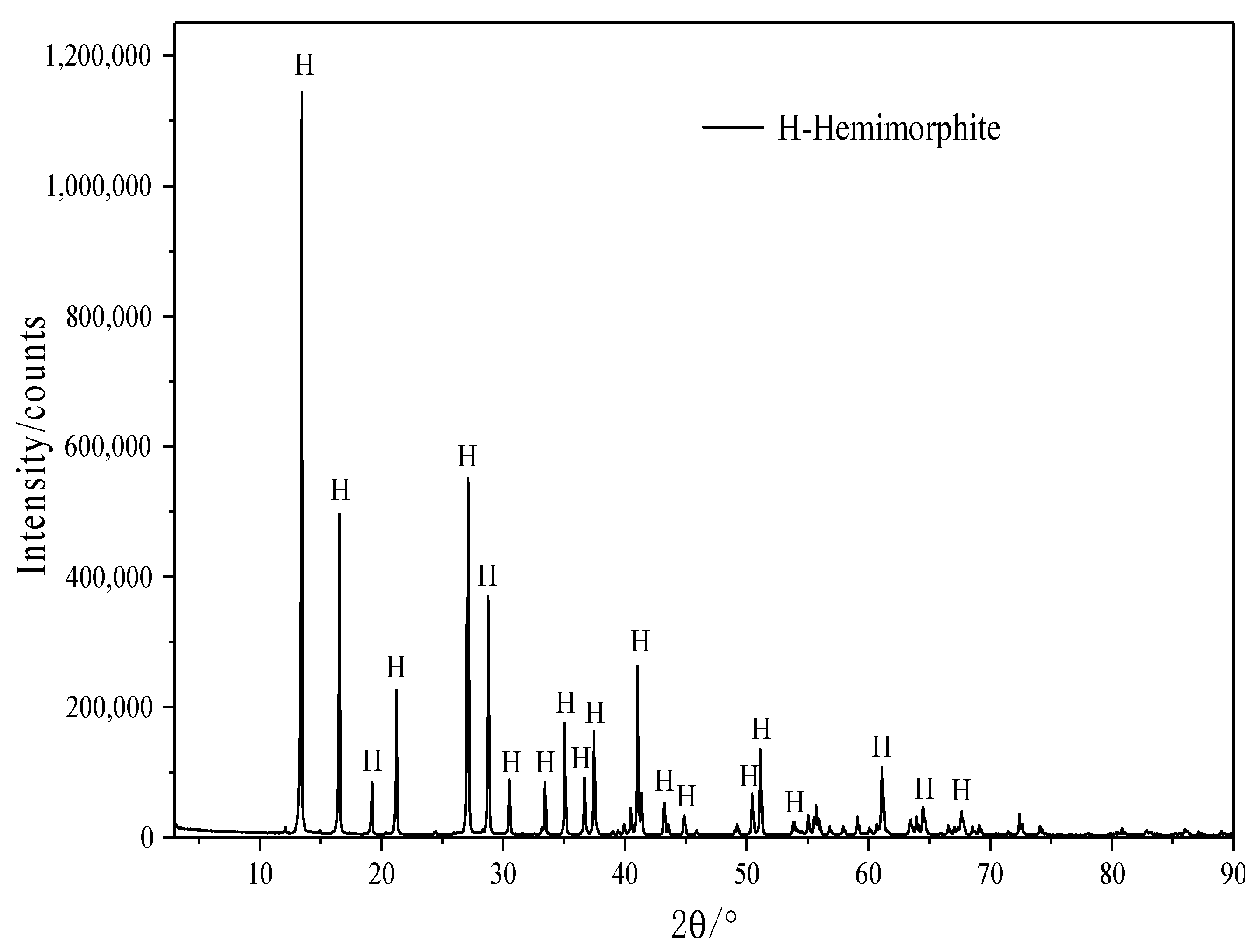
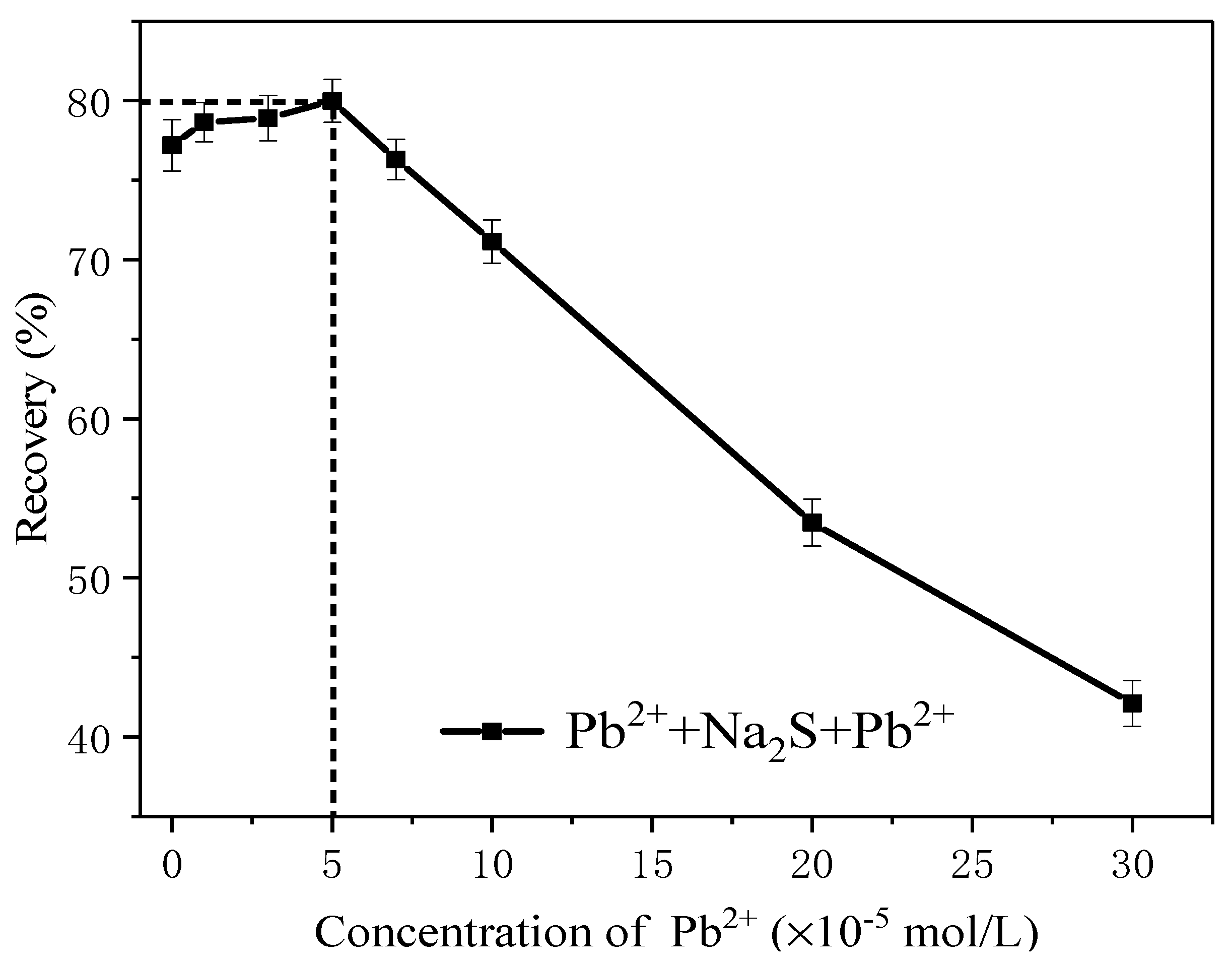
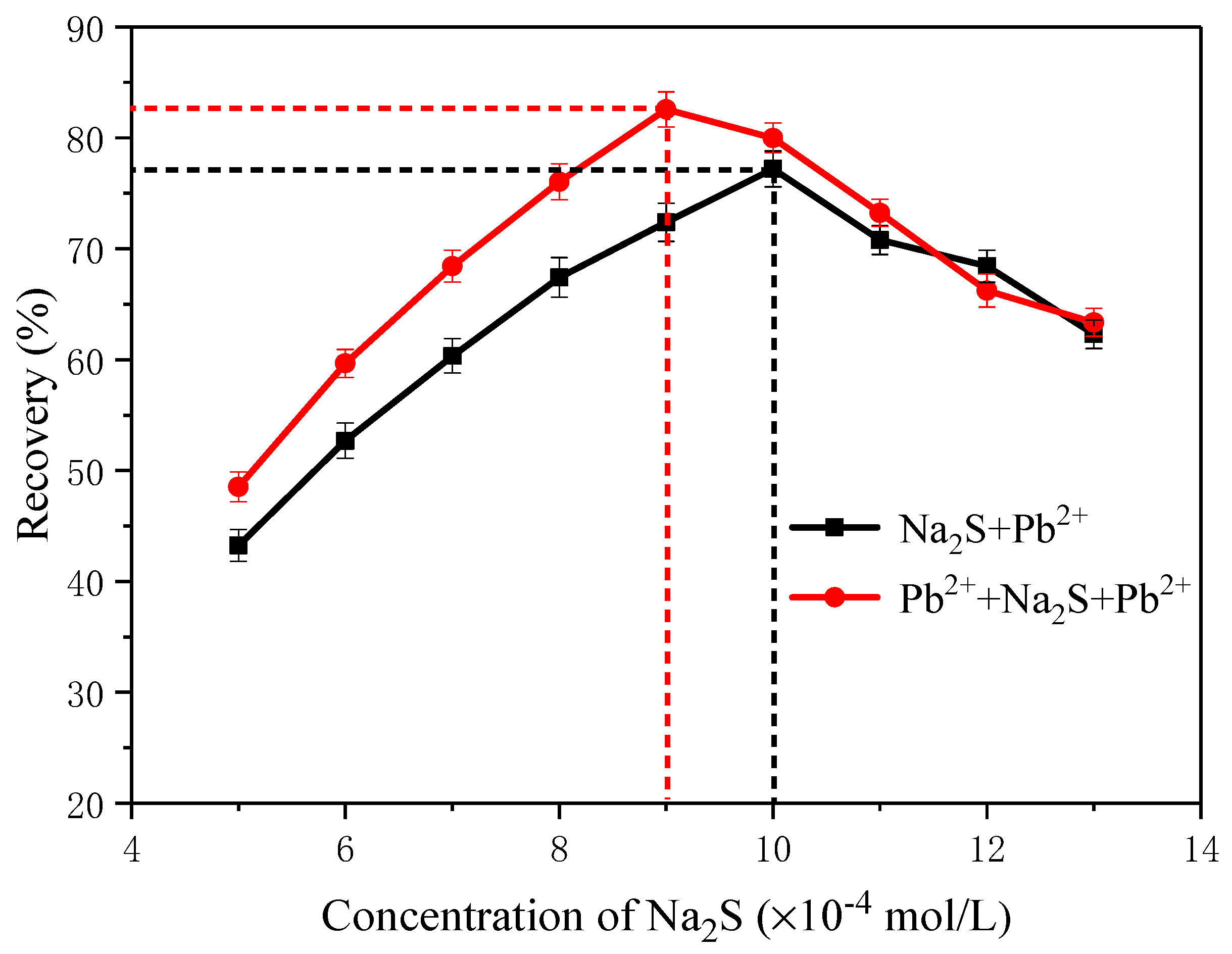
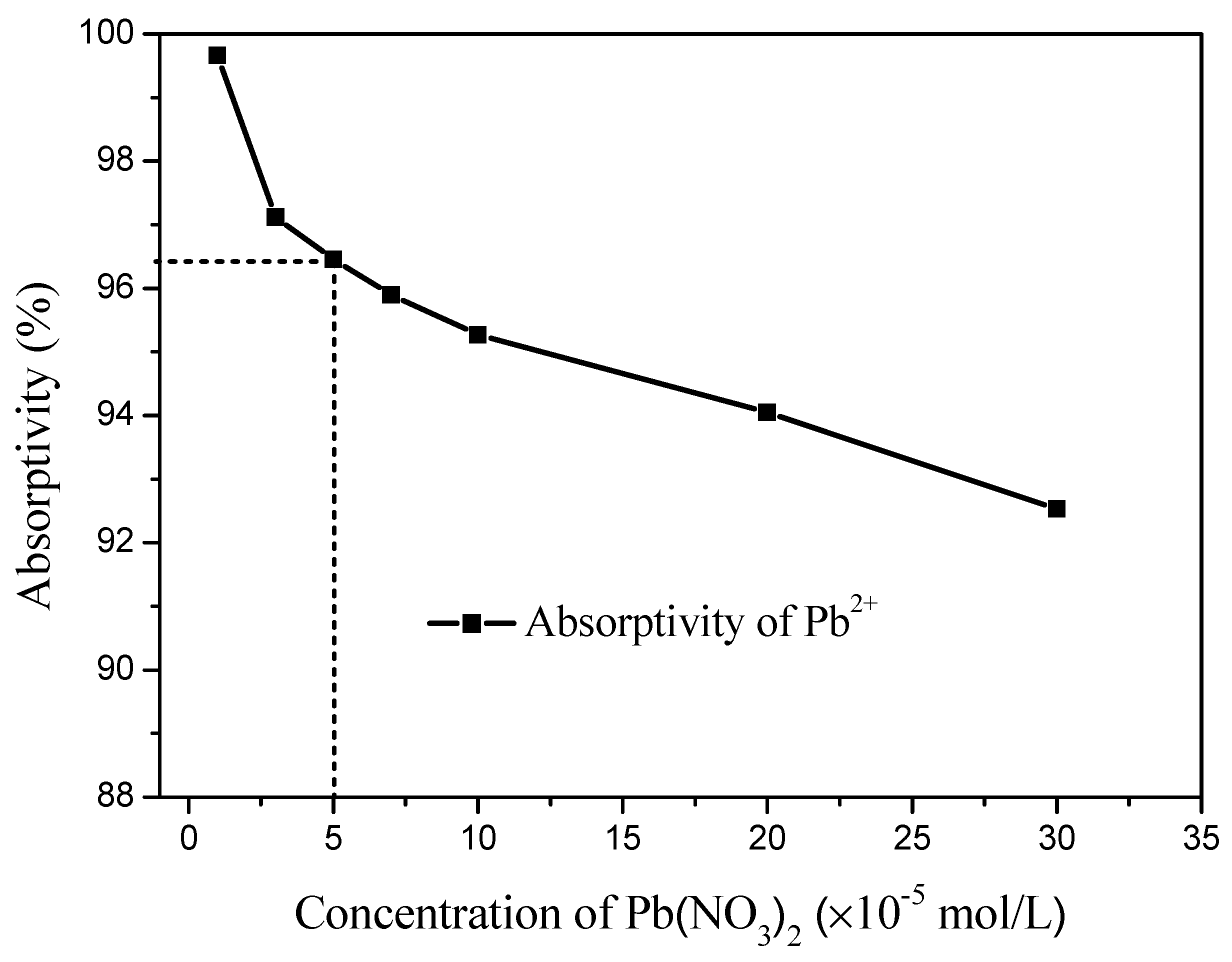
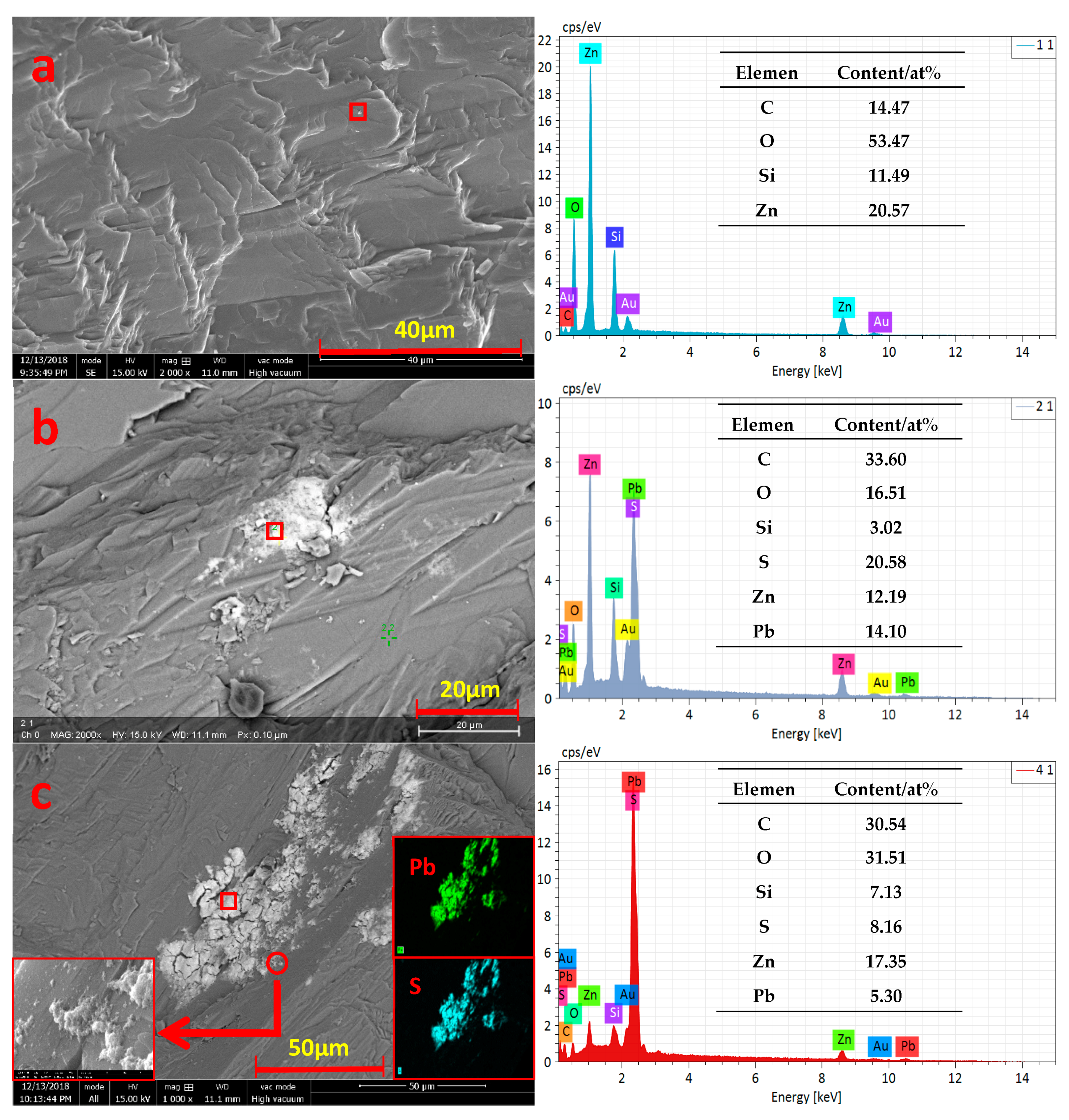
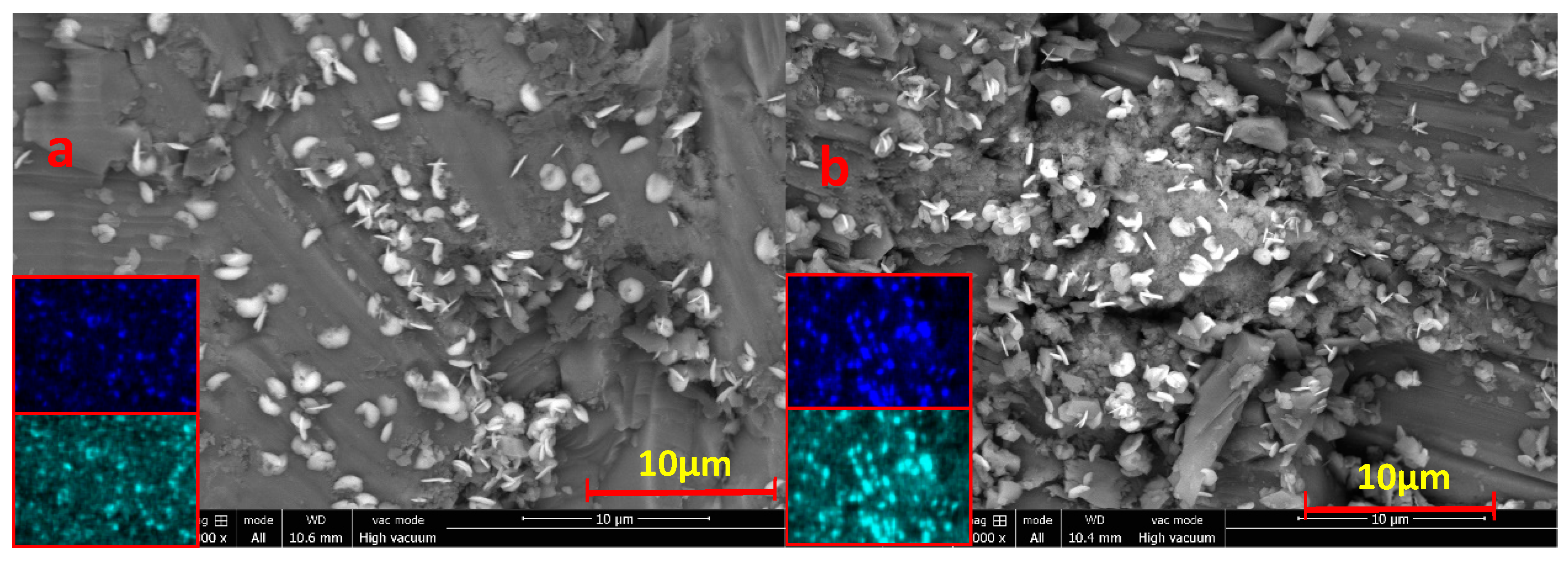
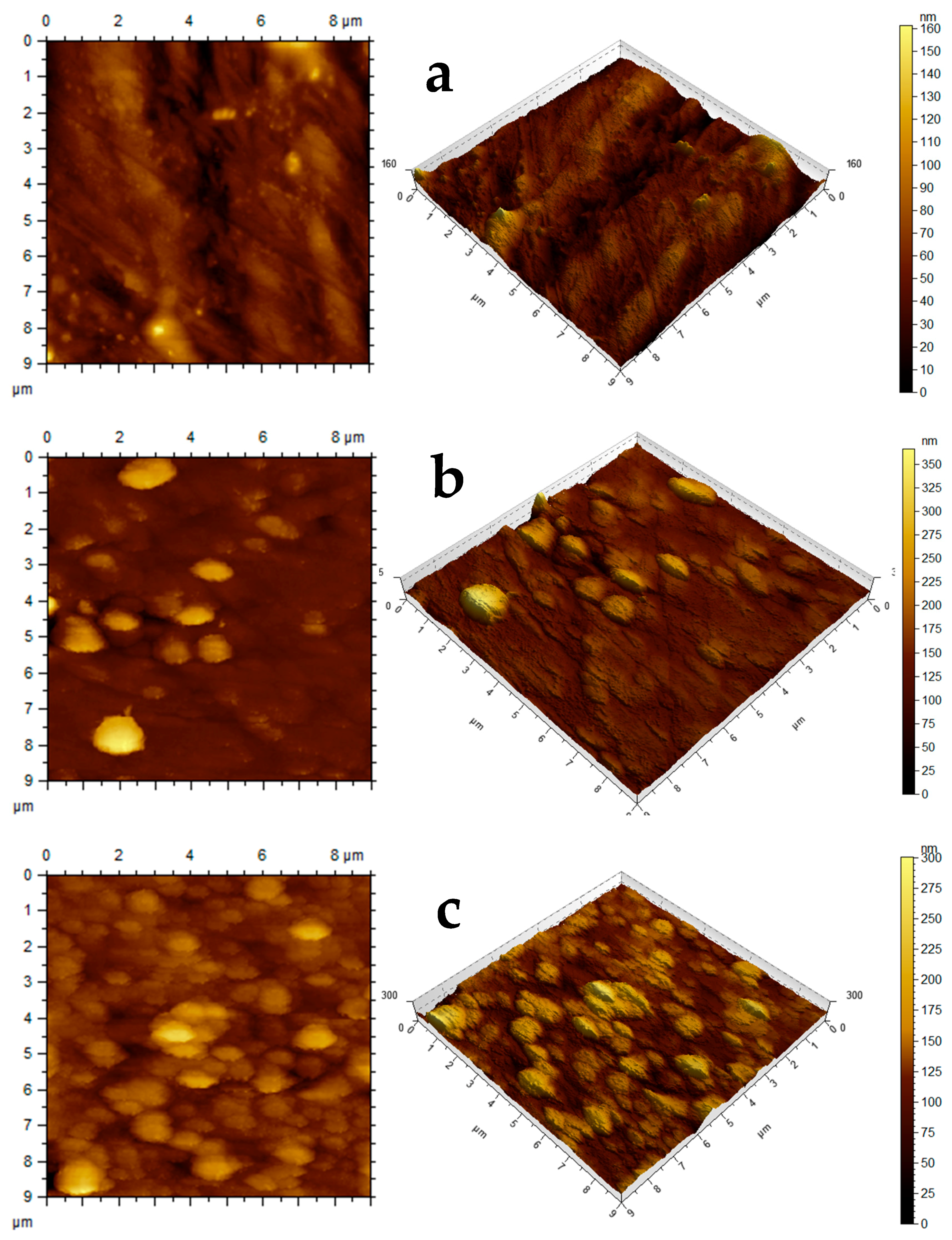
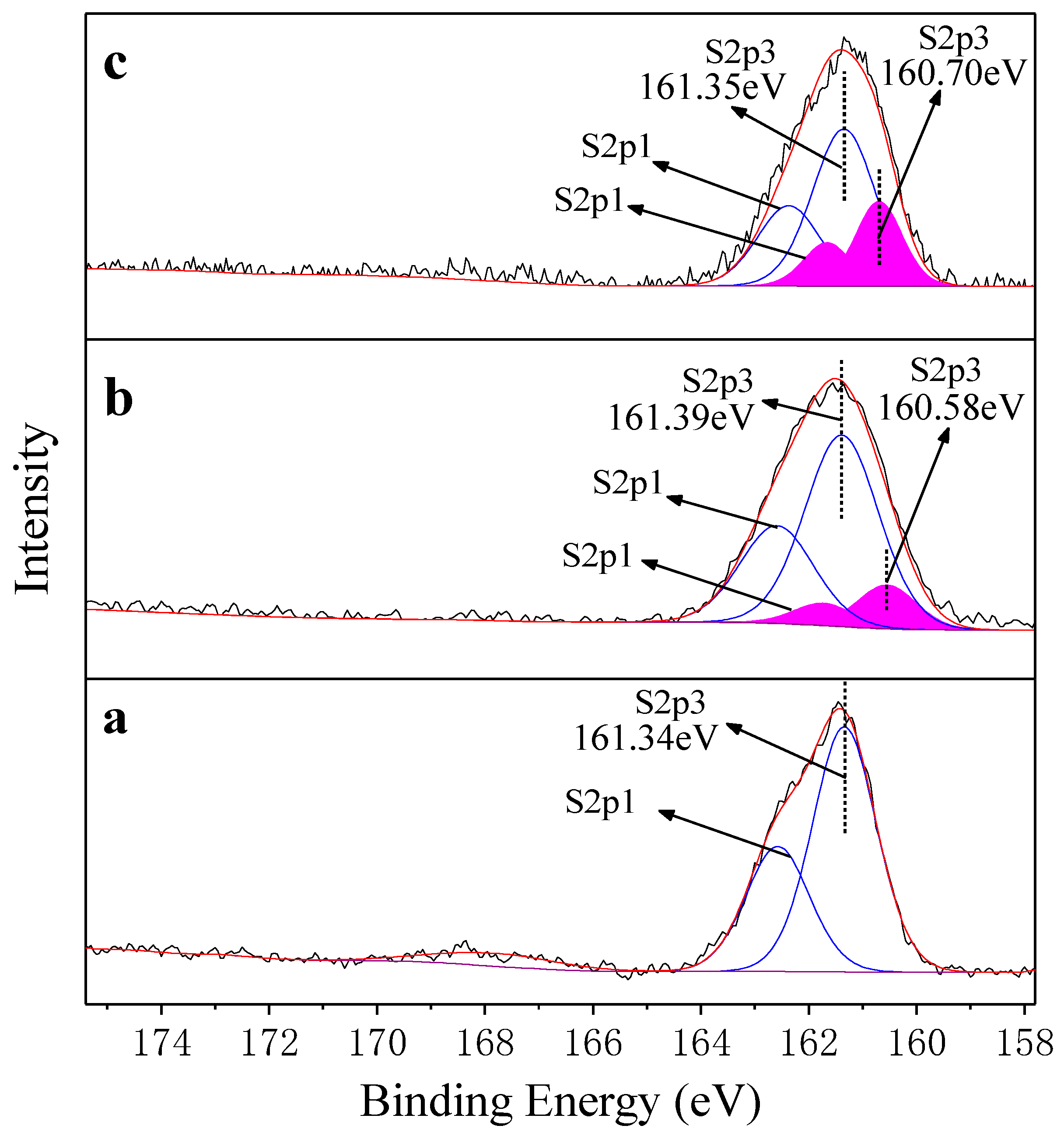
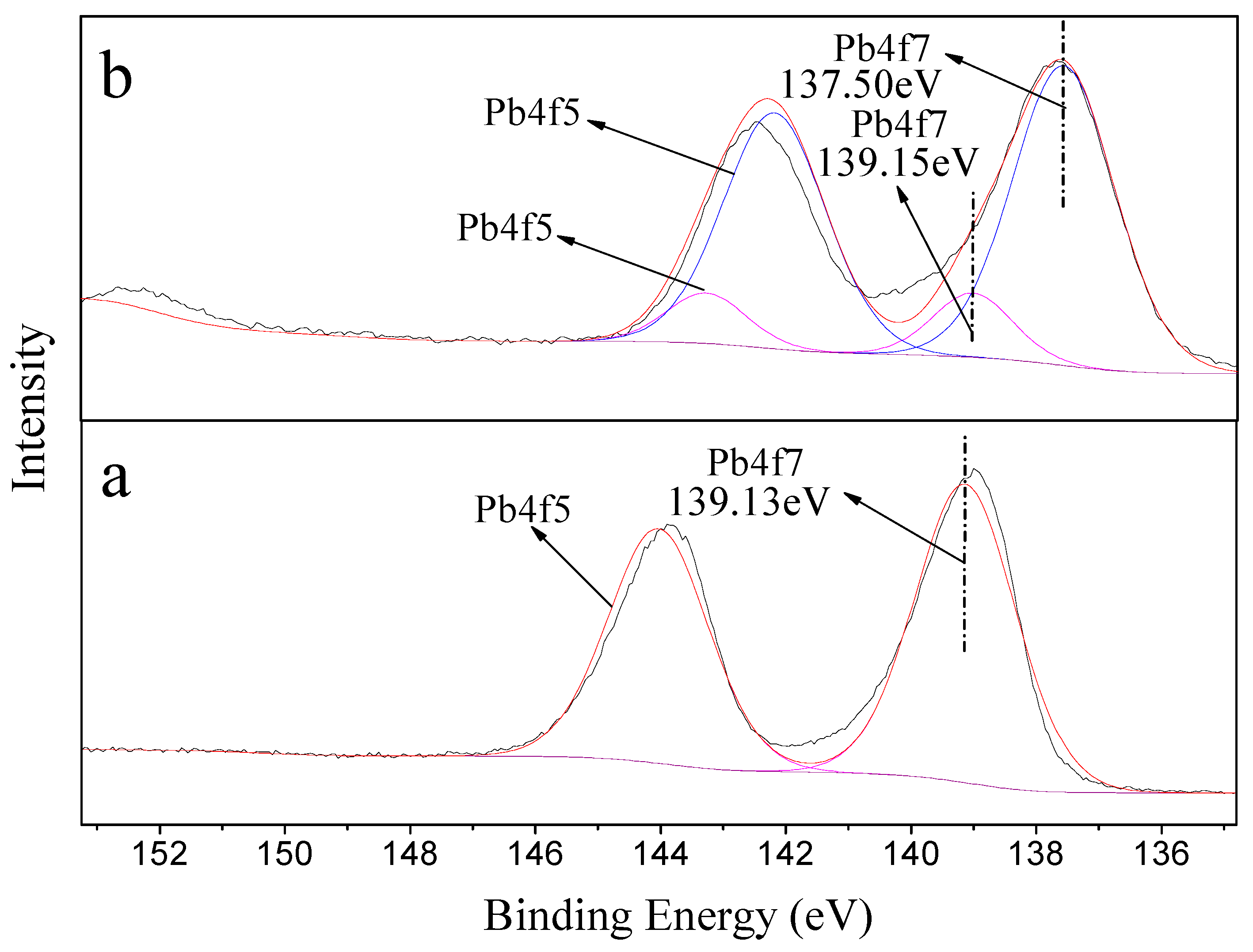
| Initial Na2S·9H2O Concentration (mol/L) | Residual S Concentration in Pulp Solution (mg/L) | |
|---|---|---|
| Without Pb2+ Pretreatment | With Pb2+ Pretreatment | |
| 5 × 10−4 | 2.464 | 1.280 |
| 6 × 10−4 | 3.331 | 1.772 |
| 7 × 10−4 | 4.652 | 2.731 |
| 8 × 10−4 | 6.117 | 4.023 |
| 9 × 10−4 | 7.701 | 4.929 |
| 10 × 10−4 | 8.928 | 6.925 |
| 11 × 10−4 | 11.273 | 9.226 |
| 12 × 10−4 | 14.015 | 11.723 |
| 13 × 10−4 | 16.732 | 13.628 |
© 2019 by the authors. Licensee MDPI, Basel, Switzerland. This article is an open access article distributed under the terms and conditions of the Creative Commons Attribution (CC BY) license (http://creativecommons.org/licenses/by/4.0/).
Share and Cite
Huang, Y.; Yin, W.; Deng, R.; Xing, D.; Rao, F. Strengthening Sulfidation Flotation of Hemimorphite via Pretreatment with Pb2+. Minerals 2019, 9, 463. https://doi.org/10.3390/min9080463
Huang Y, Yin W, Deng R, Xing D, Rao F. Strengthening Sulfidation Flotation of Hemimorphite via Pretreatment with Pb2+. Minerals. 2019; 9(8):463. https://doi.org/10.3390/min9080463
Chicago/Turabian StyleHuang, Yuqing, Wanzhong Yin, Rongdong Deng, Dingquan Xing, and Feng Rao. 2019. "Strengthening Sulfidation Flotation of Hemimorphite via Pretreatment with Pb2+" Minerals 9, no. 8: 463. https://doi.org/10.3390/min9080463
APA StyleHuang, Y., Yin, W., Deng, R., Xing, D., & Rao, F. (2019). Strengthening Sulfidation Flotation of Hemimorphite via Pretreatment with Pb2+. Minerals, 9(8), 463. https://doi.org/10.3390/min9080463







